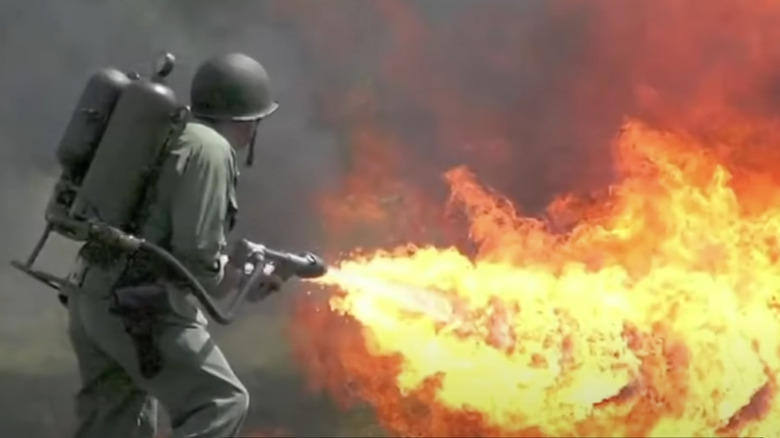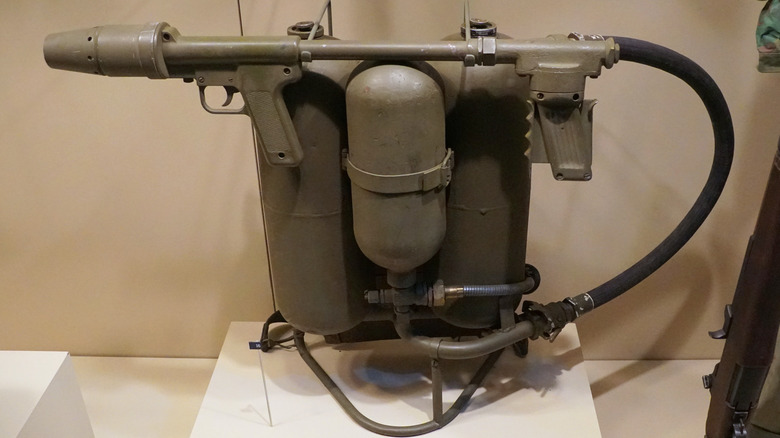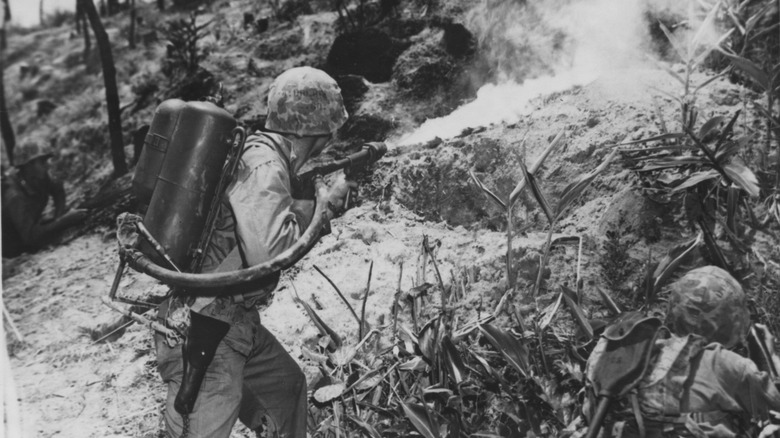What Is The M2 Flamethrower And How Was It Used In World War II?
Fire is known as an equalizer. Since its discovery by our ancient ancestors, mankind has sought to use and control it. Therefore, it should come as no surprise that we made early work at militarizing fire. These early attempts are best represented in the form of Greek fire. It is credited as having been created by Kallinikos of Heliopolis in the seventh century and used by the Byzantines in defense of their empire. It was mostly deployed against enemy vessels in defense of Constantinople and was projected from tube-like devices called siphons. A smaller, hand-held version called the cheirosiphon was also developed which could be used on land.
It would not be until World War I that the modern concept of a military flamethrower made its debut. Created and developed by German Richard Fiedler in 1901, the Flammenwerfer would not see large-scale action until the Battle of Verdun in 1916. This weapon could spray fire at a distance of up to 120 feet and was so horrible that an anonymous French officer at the time described it as "something too terrible for words." Those early flamethrowers were bulky, requiring two-man teams to manage. The U.S. military would improve upon the design and function with the introduction of the M1 in 1942 followed by the more refined M2 in 1944.
The basics of the M2 Flamethrower
The M1 flamethrower saw combat in the jungles and islands of the Pacific Theater during World War II, which quickly highlighted its problems. With finicky ignition, a range of only 15 yards, and weighing a hefty 68 pounds, the M1 was troublesome and needed further refinement. Improvements came to the flamethrower with the introduction of the M2 which sought to address the issues of the previous model. The M2 weighed slightly less at when filled, had a more reliable ignition system, and saw an increased range of between 20 and 40 yards. The introduction of napalm for use with the M2 allowed for more fire control and lethality, as it could stick to most buildings and bunkers.
The makeup of the M2 is simple, consisting of just a few components. It contains two side-by-side fuel tanks, a tank of compressed air that forces fuel through the line, and a regulator. Next is that of the flamethrower gun itself, which is connected to a fuel hose and utilizes two triggers along with cartridges of igniters. This is all attached to a backpack rig for field use. To fire the M2, the operator could simply open the regulator valve, squeeze the back safety trigger on the gun to release the fuel from the tanks into the hose, and then pull the front igniter trigger to release a stream of flame.
The M2 in action
The M2 entered the war late but was extremely useful to Army soldiers and Marines in combating entrenched Japanese forces. The Japanese had proven adept at constructing bunkers, pillboxes, and tunnel fortifications that were resistant to normal weapons during the Pacific campaign. To get at these enemy positions, soldiers and marines equipped with M2s would be called in to sanitize the location. The fearsome power of the M2 flamethrower was so infamous that Japanese defenders chose to kill themselves rather than be burned alive.
Those soldiers that went into battle with the M2 had a terrifying weapon to use, but one that also made them targets for enemy snipers. A single bullet could ignite their fuel tanks causing an explosion that would kill them and anyone else nearby. Even with these fears, the M2 Flamethrower was used to great effect in the island-hopping strategy by many brave servicemen. This is exemplified by Cpl. Hershel "Wood" Williams on February 23, 1945, when, as dictated in his Medal of Honor citation, "daringly mounted a pillbox to insert the nozzle of his flame thrower through the air vent, kill the occupants and silence the gun; on another he grimly charged the enemy riflemen who attempted to stop him with bayonets and destroyed them with a burst of flame from his weapon."


